Piptospatha N.E.Br.
Araceae
Anubias, Aridarum, Bucephalandra, Lagenandra, Ooia
southern Thailand to West Malesia; some species are endemicendemic:
(adj) restricted to a certain geographical location
to Borneo
Piptospatha species are not frequently available, but may be acquired through trade with other hobbyists or from specialized aquarium stores
information not available
information not available
obligate or facultative rheophytesrheophytes:
(n) an aquatic plant that can live in fast-moving water currents
, occasionally lithophytic
Small to medium aroid. Stem erect or decumbentdecumbent:
(adj) (of stems) having a portion lying along the ground, with upper parts erect or ascending
 , typically condensed. Leaves basalbasal:
, typically condensed. Leaves basalbasal:
(adj) at or pertaining to the base, or point of attachment
; petiolepetiole:
(n) the stalk of a leaf
 ± round to longitudinally grooved on upper side, sheath short with long liguleligule:
± round to longitudinally grooved on upper side, sheath short with long liguleligule:
(n) (1) a strap-shaped structure; (2) an often thin, membranous or hairy structure projecting from the top of the leaf sheath in grasses and a few other families; (3) the flattened part of the ray corolla in the Asteraceae
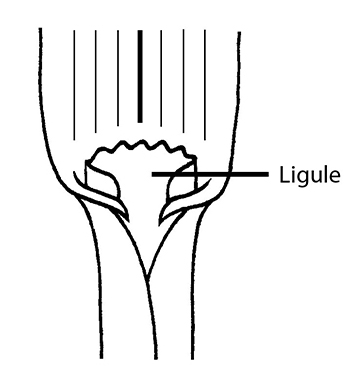 ; leaf bladeblade:
; leaf bladeblade:
(n) (syn. lamina) the flat, expanded part of a leaf, frond, or petal (excluding, e.g., the petiole)
 elongate-lanceolate to ellipticalelliptical:
elongate-lanceolate to ellipticalelliptical:
(adj) in the form of an ellipse (oval)
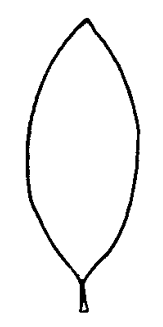 , or oblanceolateoblanceolate:
, or oblanceolateoblanceolate:
(adj) lance-shaped, with attachment at or near the narrow end. (compare lanceolate)
; apexapex:
(n) the point farthest from the point of attachment; the tip (often pointed)
with tubulartubular:
(adj) (of a corolla, perianth, calyx tube or other structure) (1) tube-shaped; cylindrical: narrow and elongate with more or less straight sides; (2) having segments fused into a tube (of any shape)
mucromucro:
(n) a short, sharp, abrupt point
; base cuneatecuneate:
(adj) wedge-shaped; triangular, with narrow end at the base
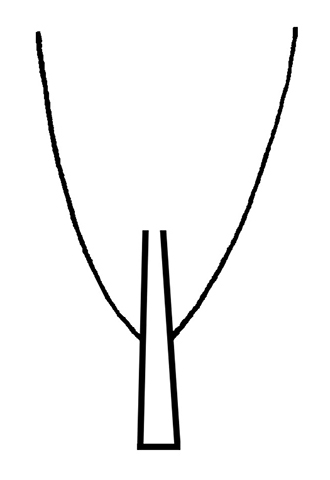 ; venationvenation:
; venationvenation:
(n) the arrangement of veins in a leaf
pinnatepinnate:
(adj) in the form of a feather; of, e.g., leaflets, lobes, or veins: arranged in two rows along an axis
with distinct marginal vein. Inflorescenceinflorescence:
(n) the arrangement of flowers on the floral axis
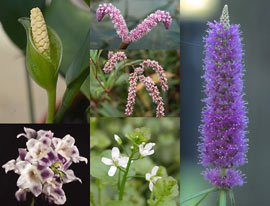 an axillaryaxillary:
an axillaryaxillary:
(adj) in, of, or produced from an axil
spathe and spadixspadix:
(n) a spike of small flowers borne on a thick, fleshy axis
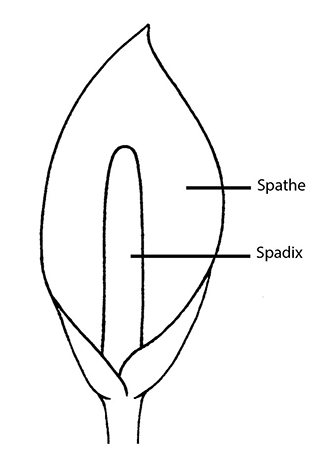 , usually nodding; pedunclepeduncle:
, usually nodding; pedunclepeduncle:
(n) the stalk of a flower cluster or inflorescence
subequal or longer than petiolepetiole:
(n) the stalk of a leaf
 ; spathespathe:
; spathespathe:
(n) a large bract or bracts subtending and often enclosing an inflorescence
 stoutly ellipsoid, not constricted, typically pink; spadixspadix:
stoutly ellipsoid, not constricted, typically pink; spadixspadix:
(n) a spike of small flowers borne on a thick, fleshy axis
 sessilesessile:
sessilesessile:
(adj) attached directly, without a stalk
 , inserted obliquely, often with sterilesterile:
, inserted obliquely, often with sterilesterile:
(adj) lacking male and/or female reproductive parts; not producing fruit, seed, pollen, spores, etc.
flowers at extreme base. Infructescence a cluster of berries, subtended by obconic spathespathe:
(n) a large bract or bracts subtending and often enclosing an inflorescence
 base; berry obovoid, small, green.
base; berry obovoid, small, green.
along streams and by waterfalls in lowland to lower montane rainforest areas
A genus of about 15 species that tolerate periodic submersion but are not considered true aquatics.